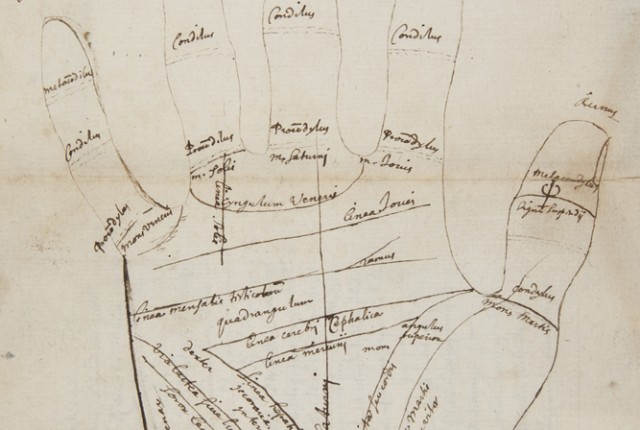
By Reading Room Assistant Stella Castillo
The riddle of your future may be solved at The Clark! Recently, I was wondering what the future may hold, so I decided to look into fortune telling and came across several books detailing how to read your palm among other things (like your moles!) to determine your future. Palmistry, also known as chiromancy, is the art of reading lines on the hand to forecast the future.

One book, in particular, the True Fortune Teller or Guide to Knowledge… (Call Number: BF1851 .T86 1698*) tells the reader in Chapter 2 that: “…first you must understand, that of all of the members of the body, none so plainly exposes our Fortunes or Fates as the Hand; for in that the God of Nature has ingraven legible Characters, to be read by the studious and industrious, to whom it is his pleasure to reveal such secrets And those are the lines and joynts, & c. apparent in the Palm, Thumb and Fingers, which have an immediate intercourse, though by devious ways, with the chief feats of life, having diverse Names.”
The method of evaluating a person’s character or future life by reading the palm of that person’s hand involves decoding the various lines and bumps. The lines have names like the life line, the head line, the heart line and the Saturne line. The palmist may begin by reading the person’s dominant hand which, according to some traditions, represents the conscious mind. According to various traditions of palmistry, the non-dominant hand may carry hereditary traits or information about past-life or karmic conditions.

The history of palmistry is hazy but it is thought to have originated in India with Hindu astrology and spread through the traditional fortune-telling practices of the Romani people to China, Tibet, Persia, Egypt and Ancient Greece. The earliest books on the topic appear in the 15th Century. During the Middle Ages the art of palmistry was actively suppressed by the Catholic Church as pagan superstition due to its associations with magic and witchcraft and it was used to detect witches. In Renaissance magic, palmistry was classified as one of the seven “forbidden arts,” along with necromancy, geomancy, aeromancy, pyromancy, hydromancy, and spatulamancy. It was believed that certain spots on the hand indicated one had made a pact with the Devil. Palmistry saw a resurgence during the 17th century, when scholars began to attempt to find rational and scientific foundations for the practice. However, palmistry was outlawed in Britain during the reign of King George IV.

I could tell you more about what your palm might say, but perhaps you should come down to The Clark and have a look at how to read your palm yourself.

